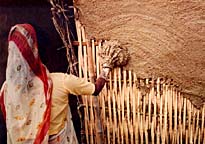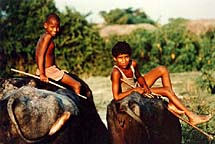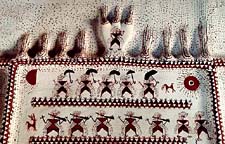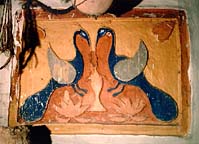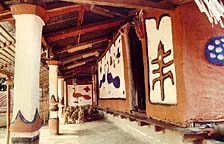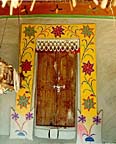|
The Tharu of the Tarai by
For the last one hundred years peoples around the world have been fascinated by Nepal because of its magnificent mountains, the towering Himalayas. Closed off from the outside world by its potentates, this kingdom lived in secluded splendor until the 1950's, when its doors officially opened to the outside world. The isolation of the Tharu in the Tarai was even more complete: living in villages located in the malaria-infested jungles of the Gangetic plains, they rarely encountered outsiders. Over the millennia they developed a unique culture free from the influence of adjacent India, or from the mountain groups of Nepal. Only recently, when DDT eradicated the malaria, did the Tarai begin to attract settlers seeking to escape the harsh and little productive lands of their own ancestors.
We have spent the past four years exploring the material culture of the Tharu, ALL of the Tharu of Nepal. Seaching the Tarai for remote villages untouched by modern life, we have scoured its full 600 mile length, from the western edge to its eastern border. Our search has taken us to nearly 300 villages, where we have discovered a rich and varied mosaic of Tharu culture and folk art. The most striking aspect of the Tharu environment is the decorated walls, partitions and rice containers of the houses. For generations Kochila Tharu women of the eastern Tarai have transformed the verandahs and outer walls of their homes into colorful outdoor canvases dedicated to Lakshmi, the Hindu goddess of prosperity and fertility, at Tihar, the festival of lights.
The third day of Tihar is devoted to worshipping Lakshmi. According to Tharu legend, on this night she circles the earth on the back of an owl, inspecting homes to see that they are properly purified with rigorous cleaning and newly painted walls. At twilight, villagers burn small oil lights to attract her attention to their houses, fields and farmyards. If she is pleased, she pays a visit and grants the family prosperity throughout the coming year. While some of the patterns on these houses are simply decorative, others contain auspicious elements. Important in South Asian mythology, the peacock adorns more painted houses than any other bird. Sanskrit literature associates it with human happiness, passion and bliss: Ram and Sita delighted in the company of peacocks, and when Sita was abandoned by Ram, it is said that the peacocks ceased to dance. Many Tharu believe if they spot a peacock when they first step out of their home, they will be favored with good luck that day. Another beloved god in Nepal is the blue-skinned Krishna, whose feats of magical strength, prowess as a bewitching lover, and devout compassion are passed on in legend from generation to generation. In the western Tarai, Dangaura Tharu celebrate his birth each year with the creation of an ASTIMKI painting in the interior of the Dangura longhouse by the male elder.
An abstract outline of a human body contains drawings and symbols which tell the stories of Krishna's many deeds, including scenes from the Mahabaratha and the Ramayana. The family (or village) elder who paints the astimki is a farmer who has no education in the arts. Even today few can read or write, but that presents no barrier to passing down the knowledge of Krishna's feats from one generation to the next. These pictures show different episodes in Krishna's life: his birth, his marriage, life in the forest, the river and the fields. The legendary five Pandava brothers march across the top of the astimki, going to battle against the forces of evil, the 100 Kaurava cousins. To the side of the Astimki, sons try their hand at depicting elements of Krishna's life, preparing to carry the tradition along. Once the day of prayer is past, these visual offerings to Lakshmi and Krishna are ignored, scuffed or brushed against during the comings and goings of daily life. While much of this art is rooted in devotional activities, todays' artist seldom knows the significance of the designs, but still clings to the graphics of the elders, occasionally introducing contemporary designs such as a bus or airplane. When we ask about the meaning of the graphic and abstract designs, we are most often simply told by the artists: "It is the tradition."
This art is ephemeral, designed for a specific devotional purpose. The richness of the design, using only available materials - clay, mud, dung and grass - always astonishes us. It has been passed down from generation to generation within the rural family, usually - but by no means always - carried out by the women. There are no schools, no art colleges, no teachers who tell them what is "right" and what is "wrong" - it is for this reason that we call it ART WITHOUT ARTISTS
Is this truly "ART" in the western sense? It is not the inspiration of an individual and it has no commercial value: it is never considered to be the intellectual property of the artist who created it. The work is one moment in the continuum of time. The anonymous artist borrows from the elders, makes some changes, is free to improve on it - within the constraints set up by the culture, and this culture belongs to all. Kurt W. Meyer and Pamela Deuel, Kathmandu, March 1997 all text and images © Kurt W. Meyer and Pamela Deuel |

